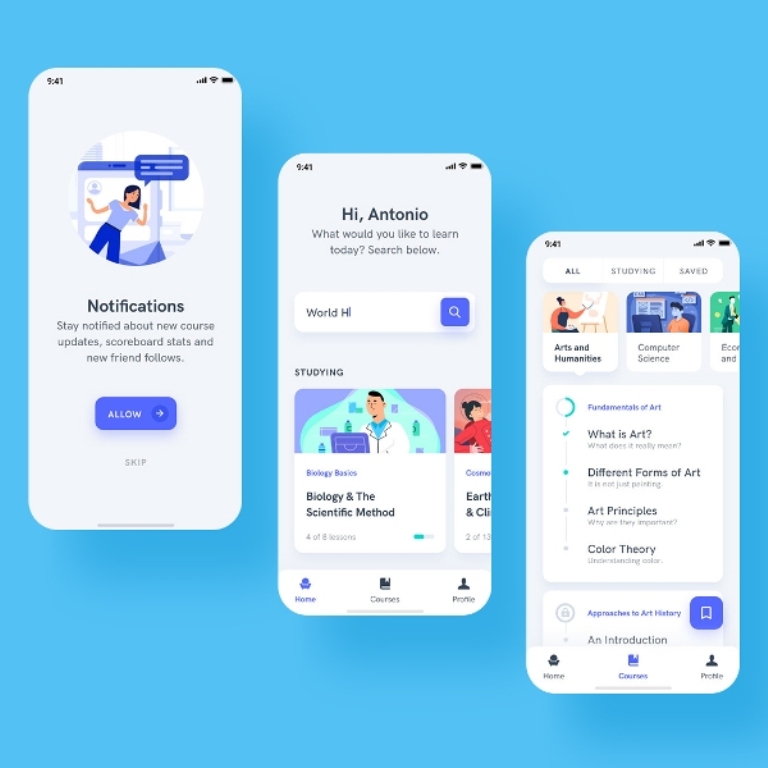Android App Development Services: The A to Z of Creating an Educational App
With the proliferation of technology and the growing demand for online courses, tuition, and training facilities, the android app development services market is witnessing a tremendous surge. The pandemic has impacted practically every segment of the market sector, and the education sector is no exception. However, it led to positive growth in the education sector, unlike the other sectors, as physical classrooms got an efficient alternative to online learning.
These are existing technologies. However, in the last two years, people are adopting them at a mass level in almost every corner of the world. The ease and convenience of smartphones and mobile apps helped people study anytime and anywhere. Learning apps are built using iOS and android app development services and offer aspirants highly interactive and user-friendly interfaces to learn their lessons.
Market insights of learning apps
The android app development services market, especially the learning app market has seen tremendous growth opportunities in the year 2021. According to Statista, the total market for eLearning worldwide is expected to grow by over $370 billion by 2026. The education segment is quickly becoming a growing source of income.
Here let’s explore how promising an eLearning industry can be:
- Over 42.3% of internet users between the age group of 16-30 use the internet for educational and study-related purposes
- Nearly 92.1 % of users go online using mobile devices
- About 29.8% of internet users watch educational videos every week
- Almost 15% of users pay for learning programs and study materials monthly
- About 93% of companies in the edutech business plan to adopt online learning globally
- ‘Education’ is the second most popular category in the App Store and topmost in Google Play
- EduTech is growing at 16.3% and will grow at the rate of 2.5x by 2025
What are educational apps & why are they popular?
An educational app is unlike any other piece of mobile software. However, the catch here is that it is designed to help individuals and mostly children with remote learning. The examples of a learning or educational app may vary from basic apps teaching basic math to kids to apps acting as advanced professional training platforms for adults.
Who uses a learning app?
- Kids of different age groups, from toddlers to grown-ups, learn the basic things and ease the learning process.
- Learning aspirants and students who need help preparing for exams
- Professionals to help them earn a specialization degree or a high qualification level
- Individuals who decided to get additional education, master the necessary skills, and gain new knowledge
- Educational institutions to make digital learning platforms possible to solve different learning issues
- Online courses use such apps as a tool for a better market promotion
If you’re envisioning a customized mobile app for learning or educational purposes, you must be aware of the different types of learning apps available in the market.
Different varieties of learning apps
There are countless variations of android app development services, especially the learning apps available in the market. However, before you build your application, you need to decide which category you prefer to develop depending on your requirements and goals meant to be achieved.
Based on their purpose, the educational app variants are:
Learning Management Systems or LMS
It is a very popular type of learning app. Large companies use this app variant to unify multiple learning concepts they want to provide their employees. With the help of an LMS, a company can carry out the training of its employees, for instance. It is effortless to analyze and evaluate.
Kid’s learning apps
This is another different type of educational app for children. Such apps require knowledge of child psychology so that the apps fulfill their learning needs. These apps must also have the ability to convey essential learning goals to children while maintaining their interest, engagement, and motivation.
Classroom education apps
This type of app for teaching is called classroom apps, where there is no learning process but the management of the learning process. Such apps are usually used between parents, teachers, and students as a single platform for sharing lesson-based learning and observing students’ progress.
Educational games
In such game-style apps, learning goes hand in hand with entertainment. Though a well-thought-out and strong gamification is a rather challenging stage of creating an app, however, it makes users, particularly kids learn enjoyably.
Online Courses
These apps are built to offer learners an online platform to learn a new course or higher level of specialization in a relevant subject. In addition, these apps allow learners to upgrade their skills and qualify for certifications or degrees.
The technologies required for learning app development services
Selecting the appropriate technologies and tools is vital for building an educational app successfully. The chosen technology stack affects the app’s scalability, maintainability, development time, and costs. Below we consider the common mobile app development approaches and appropriate technologies to create an educational mobile app:
- Native app development: It is ideal for developing an educational app that will operate on either the iOS or Android platform. This approach requires using the particular technologies for the respective platforms.
- Hybrid app development: It allows for developing mobile learning apps that are both native and web. In simple words, the app core is built using web technologies wrapped in a native container. Hybrid apps behave much like websites but also have features that can be used effectively on mobile devices.
- Web app development: It means building apps that employ remote servers and operate on a mobile device.
- Backend development: If the aim is to collect statistical data about your users, manage payments, give users access to their data, and synchronize data between different devices, this is critical.

The essential features of a learning app
Developing any app demands a very common thing- the salient features that make it stand out and help realize the business vision. As a rule, a learning mobile app has two distinct types of users: teachers and students. Listed below are the key features you should include in your education app development, keeping these two different user bases in mind. Let’s dive in!
For teachers
- Authorization: Educators can start using the app by signing in to the system via email or phone numbers.
- Registration: Teachers can start using the app by signing in to the system via email IDs or phone numbers.
- Profile: Teachers can create personal profiles with names, courses offered, job titles, certificates, qualifications, contact information, etc.
- Course management: With dashboards, teachers can effectively manage courses and perform the following tasks- view progress, student details, and tests. They can also comment on completed assignments, share feedback, and give marks. Teachers can also upload learning materials like videos, photographs, PDF documents, and other interactive exercises to take tests.
- Evaluations or Tests: Teachers need to evaluate the ability of students regularly. This feature allows them to create various options like tests with several questions and answers, multiple-choice, objective yes/no questions, etc.
For students
- A customizable profile: Students can easily customize their profile pages with information about their name, what classes they got, and what tasks or assignments are incomplete.
- Advanced search: This feature facilitates students to find the right course, subjects, teacher, etc.
- Student dashboard: This feature gives students access to all vital information like their personal learning progress, purchased courses, preferred timing of classes, schedule of upcoming classes, or exams.
- Payments: Most online learning platforms offer paid classes. Students get a subscription for each course for a fixed period. While building an educational app, integrate a secure payment gateway, to ensure the highest standards of safety and convenience.
- Notifications: Students can get the latest news about any updates such as upcoming courses, received marks, timetables, etc.
- Social media integrations: This feature allows students to share their results with friends on social media platforms.
A step-by-step guide to building a learning app
Building a learning app that stands out from the crowd demands a thoughtful brainstorming that considers all subtle and vital details involved in building the app. Let’s walk you through the major steps to building a highly user-friendly and ground-breaking educational app.
STEP 1: DISCOVERY
In this step, the first and the foremost thing involved in identifying the audience and their needs. Next, you need to identify the purpose your mobile learning app development projects will serve. Next, you need to explore what devices your target audience is comfortable with, as your choice of platform will influence the technologies and frameworks your project needs.
Also Read: 12 Tips to Master Android App Development Services
So, once you are sure what exactly you want to offer, it will become easier for you to know what features and functionalities you want in the app, and that is how you move ahead to build a successful education app.
STEP 2: MARKET RESEARCH
Before you dive deep into the process of developing a learning app, it is essential to do thorough market research. At this stage, the mobile app development team conducts initial market research. It determines if your educational app idea is marketable or what can make it so.
Explore existing products and competitors, or you can even browse online resources for information. You may also conduct questionnaires among potential users or speak to stakeholders in the educational sector about their pain points.
STEP 3: PROTOTYPE & USER TEST
While market research is something you can do on your own, prototyping is typically when you want to bring in an agency with the relevant UX/UI expertise. At this point, your development team needs to work on a comprehensive app interface and screen relationships.
STEP 4: CHOOSING THE TECH STACK
Selecting the appropriate technology stack for the app will keep you on the right track. In addition, it will impact your budget, the app’s health, and the limitations you need to perform. Therefore, in the online learning market, determining the right platform ensures success for your app.
STEP 5: DEVELOPMENT
The development is divided into two parts frontend and backend development. Under frontend development, GUI & designing will occur, and the backend refers to core programming parts such as data storage, implementing functions, queries, etc. The app development backlog is split into sprints during this period, which is typically two weeks long. A project manager during this phase prioritizes tasks, tracks progress, and keeps track of the backlog.
STEP 6: QUALITY ASSURANCE & TESTING
In this stage, all the bugs get eliminated from the app, and the user experience is tested. This stage also requires the participation of the entire team of the app development company you have hired.
STEP 7: LAUNCHING MVP
It is time to launch the MVP, a minimum viable product. It is used for testing the idea in real-time, discovering how users interact with it, and ensuring that it will work properly or not. Once getting the user feedback, you can eliminate all the flaws.
STEP 8: DEPLOYMENT & SUPPORT
This is the stage where you release the final product to the app stores for users to download. Now that you have successfully developed and tested your app, you need to publish it in the app stores. Once released, you will begin monitoring it for crash reports and other user-reported issues to provide ongoing maintenance.
Choose a suitable android app development services monetization model
When choosing a monetization model for your educational app, remember that they have some characteristics that make them stand out from their contemporaries. For example, if you have an app for younger kids and want to use ad placement to generate revenue, be mindful of the strict guidelines on what you can and can’t promote to kids. However, the most profitable monetization models for e-learning apps are:
- Subscription
- Course fee
- In-app ads
- In-app purchases
- Paid installs
Final thoughts
The learning app segment is growing at an incredible pace post the pandemic as there has been a paradigm shift from conventional classrooms to virtual learning. It is also here to stay for a long time and is definitely getting bigger. Also, thanks to rising technology, making learning is more fun and interactive than ever. Therefore, let’s figure out how to create an educational mobile app to help you reach your goals and make it a better place with the power of learning!








